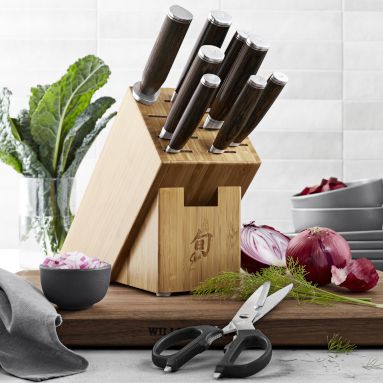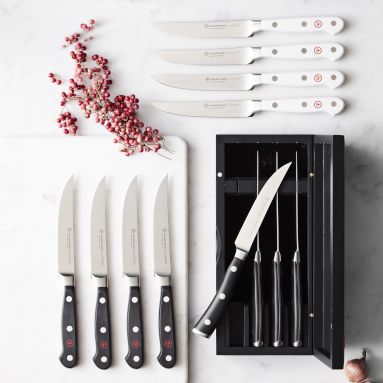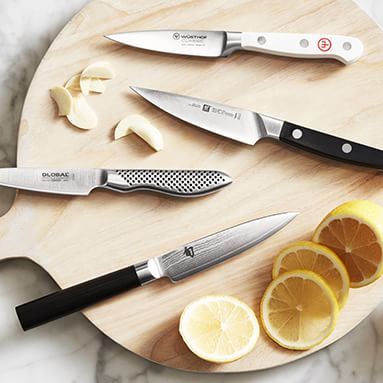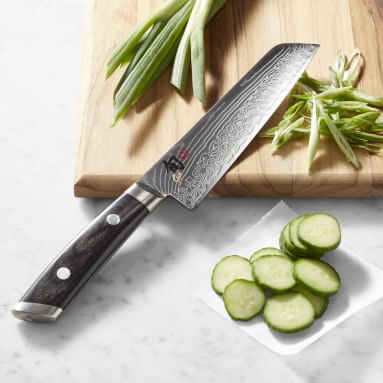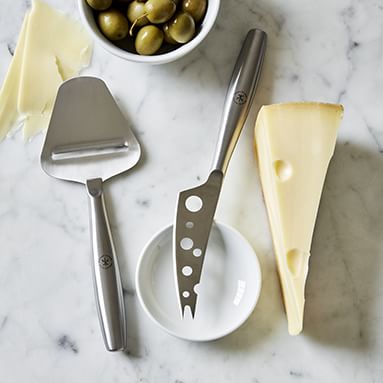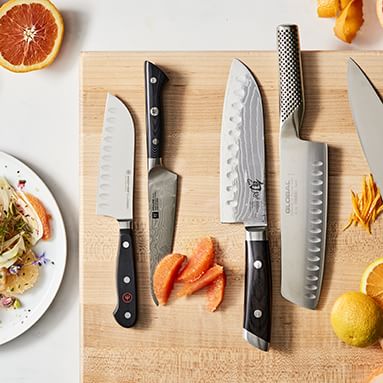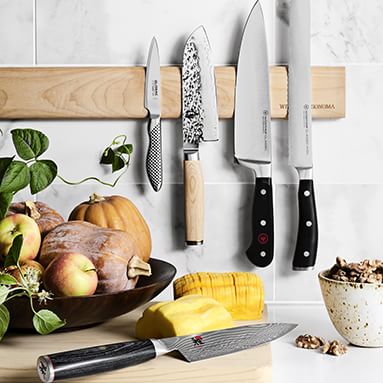All The Ways You Can Use Your Cleaver
The cleaver is an excellent example of a kitchen knife that seems to have one function, but actually has several. While most people know this humble, yet powerful hatchet as a tool for cutting into large chunks of meat, it's also great for veggies, spices, aromatics and more. While it may not replace your other knives, many people find that once they pull their cleaver out, they use it to prep the rest of the meal and not just the meat.
Shopping for A Great Cleaver
Discover the features of great cleavers when you shop Williams Sonoma's impressive range of top-notch brand names, high-quality blade styles and reliable grips for every style of home chef.
- If you already have a knife set you love, look for the same name in a butcher's hatchet. That way, the grip and balance are already familiar if not exact, since cleavers are weighted differently than other knives to allow heavy chopping power.
- Many have a hole in the upper corner of the blade. This is so you can hang yours on a hook like in a butcher shop.
- Decide how dramatic of an arch you want in the blade. If you like to give your cuts a good chop and roll motion, then a deeper arch is for you.
Butcher Uses for Your Cleavers
Cleavers are primarily a tool for butchers. Using yours to prepare a variety of meat is simple and effective, especially when you know a few tips for getting the most out of your knife.
- The most popular use is for chopping cuts of meat that have already been removed from the bone. This is often how people get their meat from their butcher or grocer.
- If you usually rely on boning knives, you'll be happy to know cleavers can debone when you use the blade at an angle, hooking the flesh with the corner of the blade.
- Move beyond hatchet cuts when you split open birds or other animals. You're still chopping but with a bit more finesse, so that afterwards, you can use the knife to shear the meat away from the bones.
Working with Spices and Aromatics
Once you've invested in a beautiful cleaver, you can use it for more than just meat.
- Some of the tasks you handle with paring knives can actually be done with cleavers, like releasing the aromas of garlic or ginger.
- Use the flat edge of the blade to crush these ingredients. Their oils impart fragrance while you maintain an interesting texture in your dishes.
- Treat the handle of the knife as a pestle. Crush whole spices on a cutting board and then use the knife blade to scoop them up and put them in your pot or pan.
Bring new functionality and ease to your cooking with this classic, versatile knife.
Prepare Delicious Cuts with A Boning Knife
Experience the difference a high-quality boning knife makes when you prepare your favorite meats, fish and poultry. This long, pointed knife is specifically designed to remove the bones from animal sides or carcasses before preparing the meat for cooking. This is a specialty knife that sticks to its main purpose. It's one that anyone who loves a juicy bird or filet should have on hand. The specific cuts of this knife help connect you to every stage of your culinary prep and result in an especially satisfying meal.
What Is A Boning Knife?
Boning knives are long and narrow knives with a highly sharp blade. At the tip of the knife is an extremely sharp point that is used to puncture meat and begin the process of deboning.
- These knives are very sharp because they are intended to remove flesh and muscle from bone and sinew. For this to be a clean, effective process, find the sharpest blade possible and keep it sharp with in-home care.
- The mid-length blade gives you enough length to dig into thicker animals or animals with deeper rib cavities. It's not so long as to make it unwieldy, though. A shorter knife is often easier to control.
- Heavier handles compared to other knives of this length help you balance your work. You need to maintain a strong grip and dextrous control to properly prepare your meat.
Butcher's or brisket knives are slight variations of the classic boning knife. A brisket knife has a wider blade to cut across the sagittal and anterior planes of the bone where brisket meat rests, right at the animal's thymus.
The Difference Between Fillet and Boning Knives
If you love to eat a lot of fish, you may want to invest in a fillet knife, too. These knives are a little different than a traditional boning knife. They're longer and more flexible.
Select The Best Boning Knife
Choose the best boning knife for you based on your kitchen and culinary preferences.
- Protective bolsters help keep fingers safe when you're working on a strong cutting motion to shear muscle from bone.
- Flexible blades are also necessary. When you cut with force, your blade needs to give so that it maintains its power instead of becoming brittle.
- Eastern or Western styles of knives can be used as boning knives. Asian styles may have a more trapezoidal profile to the blade to cut at refined angles.
- Specialty boning knives include deeply curved blades, blades that curve backwards beyond the handle or thick ends instead of a spear.
After you select a knife for deboning, be sure to pair with a high-end carving knife to serve the cooked meal.
Prep Amazing Fish Fillets with A Fillet Knife
Prepare your favorite fish dishes with a fillet knife. This specialty cutlery allows you to go from fresh fish to fully home-cooked meal in just a few steps while controlling all aspects of your meal's quality. Taking the time to make the cuts yourself allows you to season or stuff thoroughly and ensure the best parts of the fish receive the attention they deserve. Join a select group of superlative home chefs who can serve their families carefully prepared fillets every time, because they own the right knife.
What Is A Fillet Knife?
A fillet knife is a knife that is especially designed for preparing fish. While you would use a boning knife or cleaver to prepare large cuts of meat from a butcher or grocer, your filleting knife is perfect for the unique anatomy of your fish.
- The blade is long, thin and narrow. It's normal for the blade to be much longer than the handle.
- At the tip of the knife's blade is a spear or hook-shaped tip. This tip often arches backwards over the top line of the knife handle so that you can easily insert the blade into the fish.
- Smaller knives have more flexible blades. This is important so your blade can remain finely sharpened without being too brittle to make it through scales, sinew or bone.
How to Use Your Fish Fillet Knife
Using your fish fillet knife requires a simple technique that you can adjust for each fish, depending on its size and weight.
- Descale the fish with the back of the blade. This is where that arched topline can come in handy.
- Remove the fins and skin. A chopping, slicing or rocking motion with the knife gets the job done.
- Remove entrails and rinse the fish thoroughly. Take your time here. This step is the heart of the cleaning work.
- Cut lengthwise into the fish so that its sides fall away from the center. You should see fillets take shape.
- Cut each side of the fish to create fillets. The size of the fillets depends on the size of the fish.
- Run the blade along back of the spine to remove fillets. These are the pieces you season, wrap or roll with stuffings.
These kitchen tips are just the beginning. Your filleting knife is perfect for other tasks, like trimming fat from other meat, segmenting citrus and removing corn from the cob. If you go fishing to get your family's fish, you can bring your knife with you in a blade guard to scale and gut the fish in camp, too.

